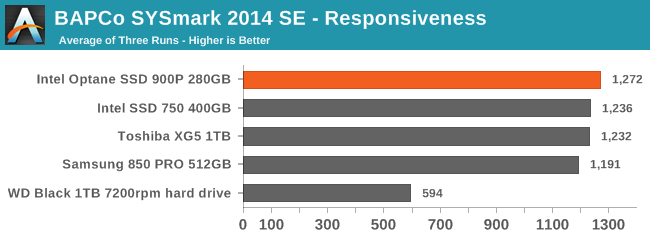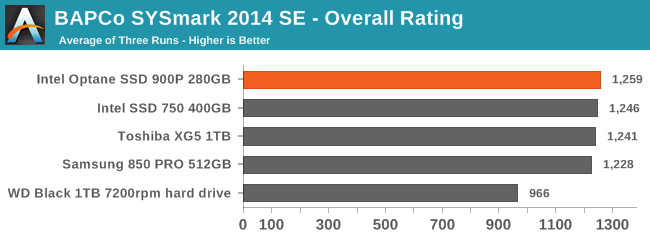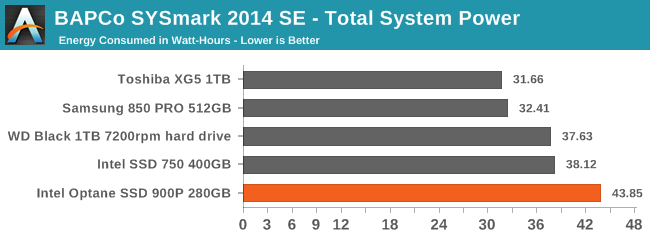The Intel Optane SSD 900P 280GB Review
by Billy Tallis on October 27, 2017 9:30 AM ESTBAPCo SYSmark 2014 SE
BAPCo's SYSmark 2014 SE is an application-based benchmark that uses real-world applications to replay usage patterns of business users in the areas of office productivity, media creation and data/financial analysis. In addition, it also addresses the responsiveness aspect which deals with user experience as related to application and file launches, multi-tasking etc. Scores are calibrated against a reference system that is defined to score 1000 in each of the scenarios. A score of, say, 2000, would imply that the system under test is twice as fast as the reference system.
SYSmark scores are based on total application response time as seen by the user, including not only storage latency but time spent by the processor. This means there's a limit to how much a storage improvement could possibly increase scores, because the SSD is only in use for a small fraction of the total test duration. This is a significant difference from our ATSB tests where only the storage portion of the workload is replicated and disk idle times are cut short to a maximum of 25ms.
| AnandTech SYSmark SSD Testbed | |
| CPU | Intel Core i5-7400 |
| Motherboard | ASUS B250-PLUS |
| Chipset | Intel B250 |
| Memory | 2x 8GB Kingston DDR4-2400 CL17 |
| Case | In Win C583 |
| Power Supply | Cooler Master G550M |
| OS | Windows 10 64-bit, version 1703 |
Our SSD testing with SYSmark uses a different test system than the rest of our SSD tests. This machine is set up to measure total system power consumption rather than just the drive's power.


SYSmark 2014 SE doesn't come close to stressing the storage system enough to show meaningful distinctions between high-end NVMe SSDs. The Responsiveness sub-test is the most sensitive to storage performance, and only shows a few percent difference between most SSDs. The overall test barely registers a difference at all. But with my primary power meter broken, SYSmark does provide a rough assessment of how power hungry the Intel Optane SSD 900P is:

The SYSmark energy usage scores measure total system power consumption, excluding the display. Our SYSmark test system idles at around 26 W and peaks at over 60 W measured at the wall during the benchmark run. SATA SSDs seldom exceed 5 W and idle at a fraction of a watt, and the SSDs spend most of the test idle.
Despite being the fastest drive in this bunch and thus the one with the shortest SYSmark run times, the Optane SSD 900P used far more energy over the course of the three SYSmark runs. With higher idle power than even the Intel SSD 750 and similar power draw under load, the Optane SSD 900P really needs its heatsink. Intel is a very long way off from being able to package this level of performance in a M.2 SSD.










205 Comments
View All Comments
ddriver - Friday, October 27, 2017 - link
"MLC/TLC NAND treated like SLC"That sounds like "a snail treated as a cheetah". I bet feeding antelopes to a snail will make it as fast as a cheetah.
There is already a huge gap in access performance between MLC and TLC. TLC drives turn pathetic the moment they run out of cache. It is physically impossible to store multiple bits and access as if it is a single bit. Neither in terms of performance, nor in terms of endurance.
We haven't even seen what SLC is truly capable of, only the very early SSDs had SLC, and back then they were crippled by the primitive and tremendously under-powered controllers. At the medium level, SLC is insanely fast.
MFinn3333 - Friday, October 27, 2017 - link
OK, no that is simply not true.Fujtisu made a drive in 2014 entirely of Intel 25nm SLC and a Sandforce 2281 controller. It was called Fujitsu FSX 240GB (And 120GB). It kicked ass for it's class and time but it is nowhere and I mean nowhere near the speeds that are here or what you are claiming.
I set a couple of them up in RAIeD-0 through both hardware and software RAID and while it did often saturat the bandwidth but only with sequential transfers. The only number that it could ever come close to matching anything here is when you are talking random writes. I could easily hit 220MB/s at 4K Random Write but it's Random Read speed was around 50MB/s at the best of times.
SLC was and is awesome and I feel comfortable with doing horrible things to those drives (I defragged them for no reason, compiled code, did multiple virtual machines including Windows 3.11, and more benchmarking than any person ever should) but it's time is over.
Get over it.
ddriver - Friday, October 27, 2017 - link
Oh wow, you are some kind of a tech genius, expecting raid to boost something other than sequential access.2014 is ancient history in the world of SSD controllers. SLC on the physical level is capable of 500-600 times better performance than what the "best" SLC controller could squeeze out of it.
I am not saying this isn't the case for xpoint as well, I am just saying SLC is far more capable than what people can imagine.
MFinn3333 - Friday, October 27, 2017 - link
"We haven't even seen what SLC is truly capable of, only the very early SSDs had SLC, and back then they were crippled by the primitive and tremendously under-powered controllers. "That is what you wrote, not about SSD's a few years ago but the very early ones. You moved your own goalposts.
SLC is about 4x faster than MLC. You are claiming it to be 500x while showing little to no evidence and roasting Intel for their claims. So either put up or shut up with your evidence.
Reflex - Friday, October 27, 2017 - link
SLC does not obey physics. Gotta take that into account. ;)chrnochime - Wednesday, November 1, 2017 - link
No comment when the other guy mentions 2014 is not "very early SSD"? Come on now. Your prejudice against anything other than SLC is showing. We all know early SSDs go back much earlier than even 2007.edzieba - Saturday, October 28, 2017 - link
If SLC were truly better and cheaper than PCM, then companies would be using it and undercutting the competition with their cheaper, faster drives with lower production costs.jospoortvliet - Friday, November 3, 2017 - link
Indeed: https://xkcd.com/808/extide - Friday, October 27, 2017 - link
Regardless of the tests used here this thing is one of the fastest storage devices available PERIOD, and it's honestly priced pretty well. It's cheaper/GB than the first SSD I bought, in fact. I could see this being used for large swaps on servers that need a huge memory footprint for a lot cheaper than a shitload of RAM, or as a ZFS L2ARC or ZIL, or for hosting a ton of VM's or for running databases off of, etc.BUT you are ddriver, the king of cynicism, so I can at least say "I got what I expected."
ddriver - Friday, October 27, 2017 - link
I am also the king of "1000 times better means 1000 times better" ;)I too got what I expected, because I expected that "1000 times better" to be a lie.
If you look at my comments, I am actually 100% objective about acknowledging the benefits of hypetane. Which is where my true biggest fault lies. How dare I be objective rather than expressing nothing short of complete awe and admiration?